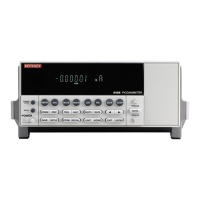9-10 Remote Operation Model 6485 Picoammeter Instruction Manual
• SRQ — You can program the instrument to generate a service request (SRQ) when one
or more errors or conditions occur. When this indicator is on, a service request has been
generated. This indicator stays on until the serial poll byte is read or all the conditions
that caused SRQ have ceased to exist.
LOCAL key
The LOCAL key cancels the remote state and restores local operation of the instrument.
Pressing the LOCAL key also turns off the REM indicator and returns the display to nor-
mal if a user-defined message was displayed. If the unit is in local (not in remote), the
local key acts as a configure key (see “Front panel summary,” page 1-6.)
If the LLO (Local Lockout) command is in effect, the LOCAL key is also inoperative.
Programming syntax
The following paragraphs cover syntax for both common commands and SCPI commands.
For more information, see the IEEE-488.2 and SCPI standards.
Command words
Program messages are made up of one or more command words.
Commands and command parameters
Common commands and SCPI commands may or may not use a parameter. The following
are some examples:
*SAV <NRf> Parameter (NRf) required.
*RST No parameter used.
:DISPlay:ENABle <b> Parameter <b> required.
:SYSTem:PRESet No parameter used.
Put at least one space between the command word and the parameter.
• Brackets [ ] — Some command words are enclosed in brackets ([ ]). These brackets
are used to denote an optional command word that does not need to be included in
the program message. For example:
:INITiate[:IMMediate]
These brackets indicate that :IMMediate is implied (optional) and does not have to
be used. Thus, the above command can be sent in one of two ways:
:INITiate or :INITiate:IMMediate
Notice that the optional command is used without the brackets. When using
optional command words in your program, do not include the brackets.

